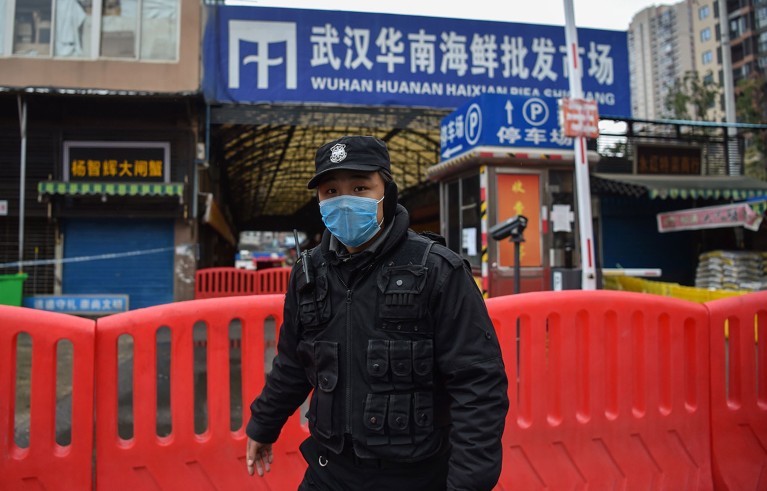
COVID pandemic started in Wuhan market animals after all, suggests latest study

Some of the earliest cases of COVID-19 were linked to the Huanan Seafood Wholesale Market in Wuhan, China.Credit: Hector Retamal/AFP Via Getty
The hunt for the origin of the COVID-19 pandemic has new leads. Researchers have identified half a dozen animal species that could have passed SARS-CoV-2, the coronavirus that causes COVID-19, to people, by reanalysing genomes collected from an animal market in Wuhan, China1. The study establishes the presence of animals and the virus at the market, although it does not confirm whether the animals themselves were infected with the virus.
Many of the earliest cases of COVID-19 were linked to the city’s Huanan Seafood Wholesale Market, and so it became a focus in the search for the pandemic’s origin. The study, published in Cell today, is the latest in a series of analyses of the market samples. The researchers argue that their reanalysis adds more weight to the market being the site of the first spillover events, in which animals with the virus infected people, sparking the pandemic. This expands on a preliminary analysis on a subset of the China CDC data, which the same team published in March 2023.
However, the team’s conclusion differs from the first peer-reviewed analysis of the data, published in Nature2 in April last year, in which a separate team also identified several animals and the virus but concluded the role of the market in the pandemic’s origin was unclear.
The search for how the pandemic began has been hugely controversial. Most researchers say the virus originated in bats who infected people, most probably through an intermediate animal, as has happened with other pathogens that have emerged in humans. But a lack of strong evidence for an intermediate host has led some researchers to argue that the virus could have escaped — deliberately or accidentally — from the Wuhan Institute of Virology.
Market stalls
The genomic data used in the Cell, Nature and other analyses were collected by researchers at the Chinese Center for Disease Control and Prevention (China CDC) shortly after the market was shut down on 1 January 2020. Over several weeks, China CDC staff visited the market many times to swab stalls, rubbish bins, toilets, sewage, stray animals and abandoned frozen animal products. The samples contained lots of DNA and RNA from multiple sources that researchers had to sequence and sift through.
“It’s one of the most important data sets on the early pandemic and on the origin of SARS-CoV-2,” says Florence Débarre, an evolutionary biologist at the the French national research agency CNRS, and co-author of the Cell analysis.
When researchers at the China CDC published their analysis in Nature last April, they reported samples that contained SARS-CoV-2 and came from wild animals in the market, most noteably raccoon dogs (Nyctereutes procyonoides), which are susceptible to SARS-CoV-2 and can spread the virus to other animals. But the team noted that there was no way to establish that the animals were infected with SARS-CoV-2. Even if they were infected, they could have caught the infection from a person who brought the virus to the market, which leaves open the possibility that the market was not the site of the pandemic’s emergence.
New techniques
The latest study used more-sophisticated genomic techniques to identify species represented in the samples, including half a dozen animals the team say are possible intermediate hosts of SARS-Cov-2. The most likely hosts include raccoon dogs and masked palm civet (Paguma larvata), which also might be susceptible to the virus. Other possible hosts include hoary bamboo rats (Rhizomys pruinosus), Amur hedgehog (Erinaceus amurensis) and the Malayan porcupine (Hystrix brachyura), but it is unclear whether these animals can catch SARS-CoV-2 and spread the infection. The team say the Reeves’s muntjac (Muntiacus reevesi) and the Himalayan marmot (Marmota himalayana) could also be carriers, but are less likely than the other species.
The co-location of viral and animal genetic material is “strongly suggestive” that the animals were infected, says Gigi Gronvall, a biosecurity specialist at Johns Hopkins University in Baltimore, Maryland. “I was quite amazed by how many animals were there,” she says.
Bats, from which the progenitor of SARS-CoV-2 probably originated, were not detected in the genetic data. The lack of bat DNA is unsurprising, says Alice Hughes, a conservation biologist at the University of Hong Kong who studies bats and the wildlife trade. Although bats are commonly eaten in southern China, they are not typically sold in the country’s markets.
The authors of the Cell study also argue that the viral diversity present in the market suggests it was the site of the pandemic’s emergence. In particular, they say the presence of two SARS-CoV-2 lineages — known as A and B — circulating in the market suggests that the virus jumped twice from animals to people. The researchers conclude that, although it is possible that infected humans brought the virus to the market on two separate occasions, that is a much less likely scenario than the virus jumping twice from animals, especially since their analysis suggests that very few people would have been infected at that point and it is unlikely that one person seeded both lineages. “It really just fits this ongoing infection in animal populations that spilled over multiple times to people,” says Gronvall.
Nature’s news team reached out to the authors of the Nature paper, asking them about the results and conclusions of the latest study, but did not receive a reply before deadline.
Southern China
The latest study also suggests that the raccoon dogs at the Huanan market were probably more closely related to wild raccoon dogs collected at other markets in the same province, and not as closely related to farmed animals found in northern Chinese provinces, suggesting they could have originated from central or southern China. The closest-known relatives of SARS-CoV-2 have been isolated from bats in southern China, Laos and other countries in southeast Asia.
The next step would be to follow some of these leads by studying animals in the wildlife trade, says study co-author Joshua Levy, an applied mathematician at the Scripps Research Institute in La Jolla, California. The paper provides actionable information about how to prevent future spillovers, he says, such as by tracking down stallholders and testing animals for viruses closely related to SARS-CoV-2, as well as conducting studies on the susceptibility of the wild mammals found at the market to SARS-CoV-2, and whether these animals can readily transmit the virus.
For Hughes, the findings demonstrate that the wildlife trade needs to be better regulated to minimize the risk of pathogen spread.



